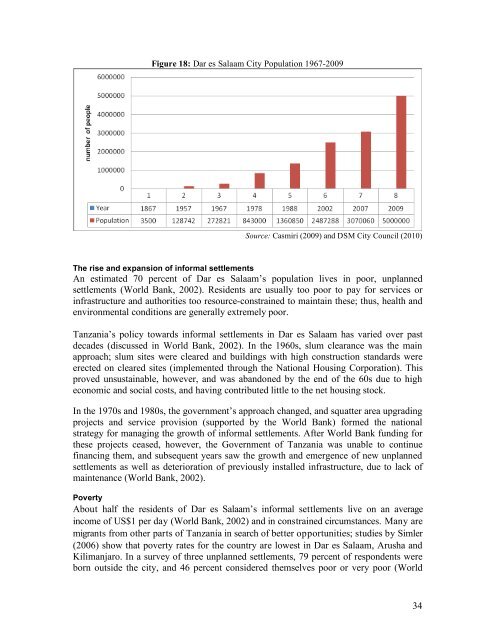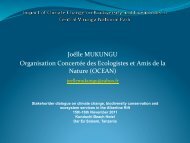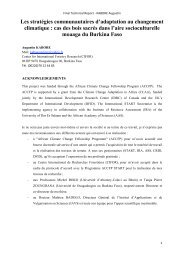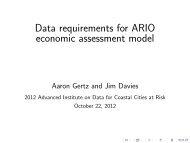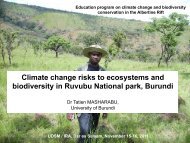Urban Poverty & Climate Change in Dar es Salaam, Tanzania:
Urban Poverty & Climate Change in Dar es Salaam, Tanzania:
Urban Poverty & Climate Change in Dar es Salaam, Tanzania:
Create successful ePaper yourself
Turn your PDF publications into a flip-book with our unique Google optimized e-Paper software.
Figure 18: <strong>Dar</strong> <strong>es</strong> <strong>Salaam</strong> City Population 1967-2009<br />
Source: Casmiri (2009) and DSM City Council (2010)<br />
The rise and expansion of <strong>in</strong>formal settlements<br />
An <strong>es</strong>timated 70 percent of <strong>Dar</strong> <strong>es</strong> <strong>Salaam</strong>’s population liv<strong>es</strong> <strong>in</strong> poor, unplanned<br />
settlements (World Bank, 2002). R<strong>es</strong>idents are usually too poor to pay for servic<strong>es</strong> or<br />
<strong>in</strong>frastructure and authoriti<strong>es</strong> too r<strong>es</strong>ource-constra<strong>in</strong>ed to ma<strong>in</strong>ta<strong>in</strong> th<strong>es</strong>e; thus, health and<br />
environmental conditions are generally extremely poor.<br />
<strong>Tanzania</strong>’s policy towards <strong>in</strong>formal settlements <strong>in</strong> <strong>Dar</strong> <strong>es</strong> <strong>Salaam</strong> has varied over past<br />
decad<strong>es</strong> (discussed <strong>in</strong> World Bank, 2002). In the 1960s, slum clearance was the ma<strong>in</strong><br />
approach; slum sit<strong>es</strong> were cleared and build<strong>in</strong>gs with high construction standards were<br />
erected on cleared sit<strong>es</strong> (implemented through the National Hous<strong>in</strong>g Corporation). This<br />
proved unsusta<strong>in</strong>able, however, and was abandoned by the end of the 60s due to high<br />
economic and social costs, and hav<strong>in</strong>g contributed little to the net hous<strong>in</strong>g stock.<br />
In the 1970s and 1980s, the government’s approach changed, and squatter area upgrad<strong>in</strong>g<br />
projects and service provision (supported by the World Bank) formed the national<br />
strategy for manag<strong>in</strong>g the growth of <strong>in</strong>formal settlements. After World Bank fund<strong>in</strong>g for<br />
th<strong>es</strong>e projects ceased, however, the Government of <strong>Tanzania</strong> was unable to cont<strong>in</strong>ue<br />
f<strong>in</strong>anc<strong>in</strong>g them, and subsequent years saw the growth and emergence of new unplanned<br />
settlements as well as deterioration of previously <strong>in</strong>stalled <strong>in</strong>frastructure, due to lack of<br />
ma<strong>in</strong>tenance (World Bank, 2002).<br />
<strong>Poverty</strong><br />
About half the r<strong>es</strong>idents of <strong>Dar</strong> <strong>es</strong> <strong>Salaam</strong>’s <strong>in</strong>formal settlements live on an average<br />
<strong>in</strong>come of US$1 per day (World Bank, 2002) and <strong>in</strong> constra<strong>in</strong>ed circumstanc<strong>es</strong>. Many are<br />
migrants from other parts of <strong>Tanzania</strong> <strong>in</strong> search of better opportuniti<strong>es</strong>; studi<strong>es</strong> by Simler<br />
(2006) show that poverty rat<strong>es</strong> for the country are low<strong>es</strong>t <strong>in</strong> <strong>Dar</strong> <strong>es</strong> <strong>Salaam</strong>, Arusha and<br />
Kilimanjaro. In a survey of three unplanned settlements, 79 percent of r<strong>es</strong>pondents were<br />
born outside the city, and 46 percent considered themselv<strong>es</strong> poor or very poor (World<br />
34


